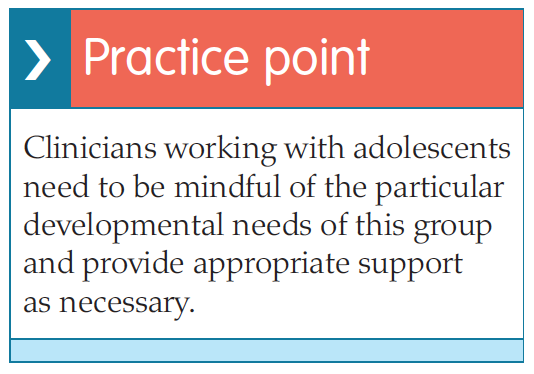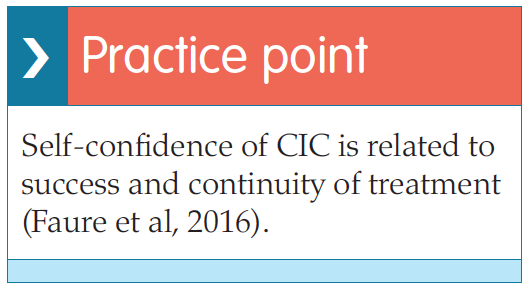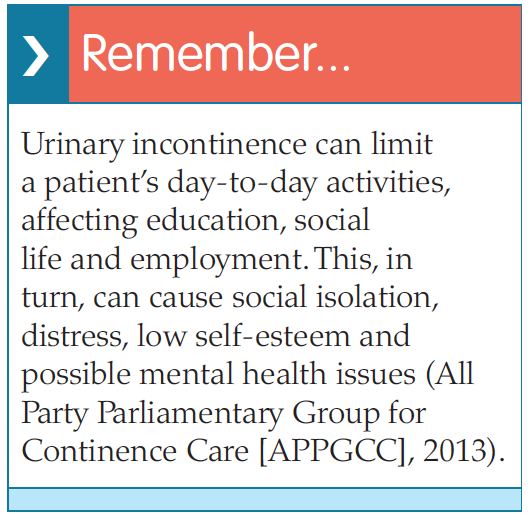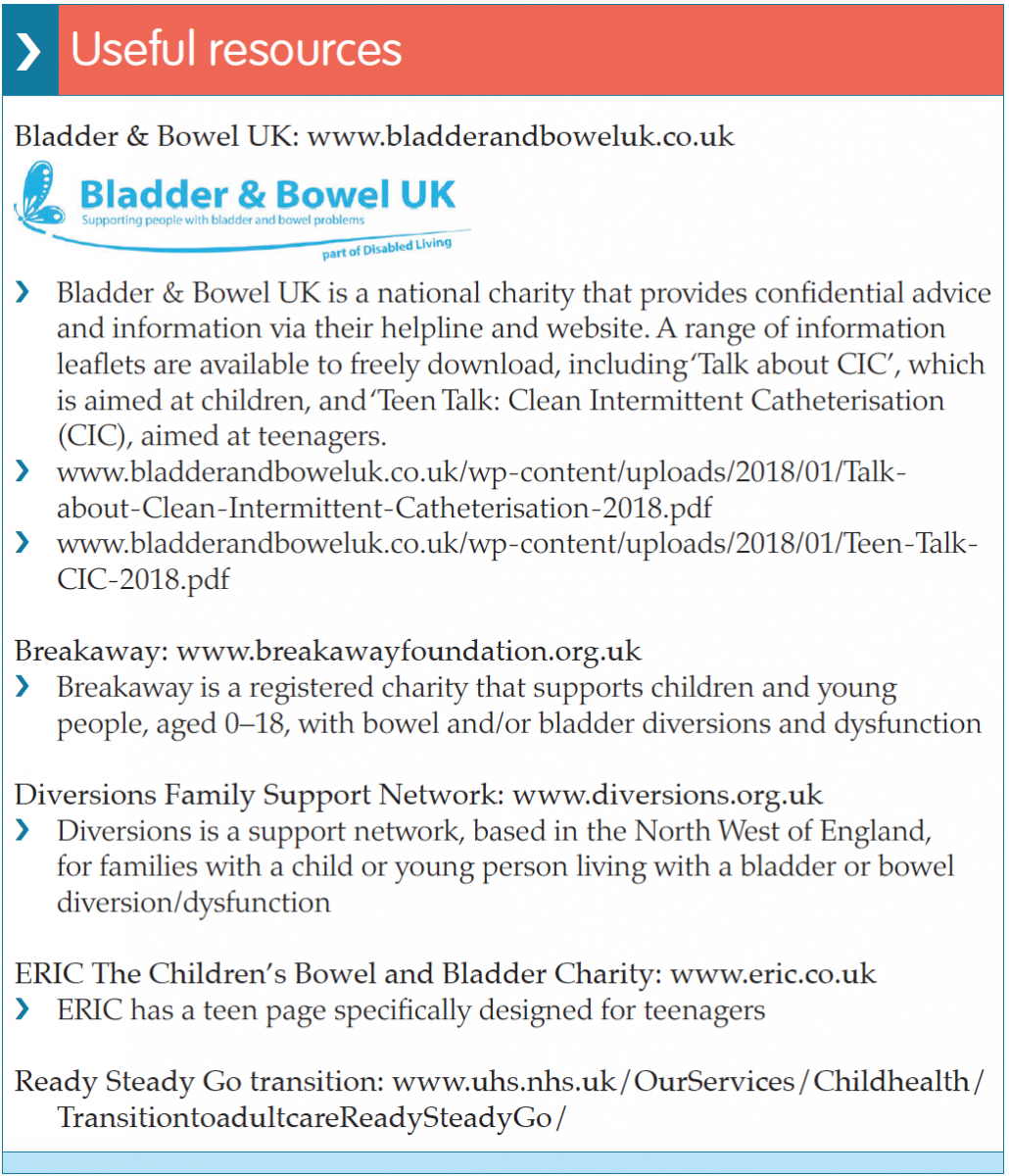References
All Party Parliamentary Group for Continence Care (2013) Continence Service. England, Survey Report. Available online: www.appgcontinence. org.uk
Alpert SA, Cheng EY, Zebold KF, et al (2005) Clean intermittent catheterization in genitally sensate children: patient experience and health related quality of life. J Urol 174(4 Pt 2): 1616–9; discussion 1619
Biaziolo CFB, Mazzo A, Martins JCA, et al (2017) Validation of a self-confidence scale for clean urinary intermittent self-catheterization for patients and health-caregivers. Int Braz J Urol 43(3): 505–11
Chapple A, Prinijha S, Salisbury H (2014) How users of indwelling urinary catheters talk about sex and sexuality. Br J Gen Pract 64(623): e364–71
Dyer K, das Nair R (2013) Why don’t healthcare professionals talk about sex? A systematic review of recent qualitative studies conducted in the United Kingdom. J Sex Med 10(11): 2658–70
Edwards M, Borzyskowski M, Cox A, Badcock J (2004) Neuropathic bladder and intermittent catheterization: social and psychological impact on children and adolescents. Developmental Med Child Neurol 46: 168–177
Faure A, Peycelon M, Lallemant P, et al (2016) Pros and cons of transurethral self-catheterization in boys: a longterm teaching experience in a pediatric rehabilitation centre. Urol J 13(2): 2622–8
Guinet-Lacoste A, Jousse M, Verollet D, et al (2014) Validation of the InCaSaQ, a new tool for the evaluation of patient satisfaction with clean intermittent selfcatheterization. Ann Physical Rehabil Med 57:159–68
Lamin E, Newman K (2016) Clean intermittent catheterization revisited. Int Urol Nephrol 48(6): 931–9
Lindehall B, Möller A, Hjälmås K, et al (2008) Psychosocial factors in teenagers and young adults with myelomeningocele and clean intermittent catheterization. Scand J Urol Nephrol 42(6): 539–44
Michaud PA, Suris JC, Viner R (2004) The adolescent with a chronic condition. Part II: healthcare provision. Arch Dis Child 89(10): 943–9
Nagra A, McGinnity P, Davis N (2015) Implementing transition: Ready Steady Go. Arch Dis Child Educ Pract Ed 100(6): 313–20
Neel KF (2010) Feasibility and outcome of clean intermittent catheterization for children with sensate urethra. Can Urol Assoc J 4(6): 403–5
Perry P (2011) Concept analysis: confidence/self-confidence. Nurs Forum 46: 218–30
Pilloni S, Krhut J, Mair D, et al (2005) Intermittent catheterisation in older people: a valuable alternative to an indwelling catheter? Age Ageing 34(1): 57–60
Pohl HG, Bauer SB, Borer JG, et al (2002) The outcome of voiding dysfunction managed with clean intermittent catheterization in neurologically and anatomically normal children. BJU Int 89(9): 923–7
Schaeffer AJ, Diamond DA (2014) Pediatric urinary incontinence: Classification, evaluation, and management. African J Urol 20: 1–13
Taskinen S, Fagerholm R, Ruutu M (2008) Patient experience with hydrophilic catheters used in clean intermittent catheterization. J Pediatr Urol 4(5): 367–71
Wilde MH, McMahon JM, McDonald MV, et al (2015) Self-management intervention for long-term indwelling urinary catheter users: randomized clinical trial. Nurs Res 64(1): 24–34
Alpert SA, Cheng EY, Zebold KF, et al (2005) Clean intermittent catheterization in genitally sensate children: patient experience and health related quality of life. J Urol 174(4 Pt 2): 1616–9; discussion 1619
Biaziolo CFB, Mazzo A, Martins JCA, et al (2017) Validation of a self-confidence scale for clean urinary intermittent self-catheterization for patients and health-caregivers. Int Braz J Urol 43(3): 505–11
Chapple A, Prinijha S, Salisbury H (2014) How users of indwelling urinary catheters talk about sex and sexuality. Br J Gen Pract 64(623): e364–71
Dyer K, das Nair R (2013) Why don’t healthcare professionals talk about sex? A systematic review of recent qualitative studies conducted in the United Kingdom. J Sex Med 10(11): 2658–70
Edwards M, Borzyskowski M, Cox A, Badcock J (2004) Neuropathic bladder and intermittent catheterization: social and psychological impact on children and adolescents. Developmental Med Child Neurol 46: 168–177
Faure A, Peycelon M, Lallemant P, et al (2016) Pros and cons of transurethral self-catheterization in boys: a longterm teaching experience in a pediatric rehabilitation centre. Urol J 13(2): 2622–8
Guinet-Lacoste A, Jousse M, Verollet D, et al (2014) Validation of the InCaSaQ, a new tool for the evaluation of patient satisfaction with clean intermittent selfcatheterization. Ann Physical Rehabil Med 57:159–68
Lamin E, Newman K (2016) Clean intermittent catheterization revisited. Int Urol Nephrol 48(6): 931–9
Lindehall B, Möller A, Hjälmås K, et al (2008) Psychosocial factors in teenagers and young adults with myelomeningocele and clean intermittent catheterization. Scand J Urol Nephrol 42(6): 539–44
Michaud PA, Suris JC, Viner R (2004) The adolescent with a chronic condition. Part II: healthcare provision. Arch Dis Child 89(10): 943–9
Nagra A, McGinnity P, Davis N (2015) Implementing transition: Ready Steady Go. Arch Dis Child Educ Pract Ed 100(6): 313–20
Neel KF (2010) Feasibility and outcome of clean intermittent catheterization for children with sensate urethra. Can Urol Assoc J 4(6): 403–5
Perry P (2011) Concept analysis: confidence/self-confidence. Nurs Forum 46: 218–30
Pilloni S, Krhut J, Mair D, et al (2005) Intermittent catheterisation in older people: a valuable alternative to an indwelling catheter? Age Ageing 34(1): 57–60
Pohl HG, Bauer SB, Borer JG, et al (2002) The outcome of voiding dysfunction managed with clean intermittent catheterization in neurologically and anatomically normal children. BJU Int 89(9): 923–7
Schaeffer AJ, Diamond DA (2014) Pediatric urinary incontinence: Classification, evaluation, and management. African J Urol 20: 1–13
Taskinen S, Fagerholm R, Ruutu M (2008) Patient experience with hydrophilic catheters used in clean intermittent catheterization. J Pediatr Urol 4(5): 367–71
Wilde MH, McMahon JM, McDonald MV, et al (2015) Self-management intervention for long-term indwelling urinary catheter users: randomized clinical trial. Nurs Res 64(1): 24–34



 Another similar study by Neel (2010) also reviewed the feasibility of CIC in children with a sensate urethra and came up with corresponding findings, but also suggested that the earlier the CIC is started, the more accepting the child is of the procedure.
Another similar study by Neel (2010) also reviewed the feasibility of CIC in children with a sensate urethra and came up with corresponding findings, but also suggested that the earlier the CIC is started, the more accepting the child is of the procedure. Another study looked at both patient and healthcare professional self-confidence in undertaking CIC by using a 16-item checklist (Biaziolo et al, 2017). Knowing how self-confident an individual is in performing CIC will not only improve teaching outcomes and compliance, but also treatment success. Self-confidence may be related to the self-efficacy theory that is constantly associated to a behaviour or task (Perry, 2011). It originates from repeated experiences and realistic perception of individual difficulties and potentials. Those individuals with a higher sense of self-confidence are both more able to undertake any challenges and correct any failures.
Another study looked at both patient and healthcare professional self-confidence in undertaking CIC by using a 16-item checklist (Biaziolo et al, 2017). Knowing how self-confident an individual is in performing CIC will not only improve teaching outcomes and compliance, but also treatment success. Self-confidence may be related to the self-efficacy theory that is constantly associated to a behaviour or task (Perry, 2011). It originates from repeated experiences and realistic perception of individual difficulties and potentials. Those individuals with a higher sense of self-confidence are both more able to undertake any challenges and correct any failures.
 When working with adolescents with long-term medical conditions, the management of these conditions is often played out against a background of rapid physical, psychological and social changes. As a result, it can often result in unique communication and management challenges. Previous studies have identified how teenagers find it difficult to accept and discuss ‘invisible’ problems (for example, the need to catheterise) with their peers (Michaud et al, 2004; Lindehall et al, 2008).
When working with adolescents with long-term medical conditions, the management of these conditions is often played out against a background of rapid physical, psychological and social changes. As a result, it can often result in unique communication and management challenges. Previous studies have identified how teenagers find it difficult to accept and discuss ‘invisible’ problems (for example, the need to catheterise) with their peers (Michaud et al, 2004; Lindehall et al, 2008).